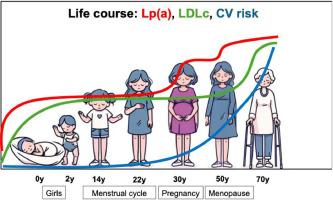Lipoprotein(a) throughout life in women
IF 4.3
Q1 CARDIAC & CARDIOVASCULAR SYSTEMS
引用次数: 0
Abstract
Lipoprotein (a) [Lp(a)] is a lipoprotein with multiple deleterious characteristics and is a recognized cardiovascular (CV) risk factor. The pro-atherogenic, pro-thrombotic, and pro-inflammatory features of Lp(a) are associated not only with atherosclerotic vascular disease but also with aortic valve calcification and all-cause mortality. One of the most interesting aspects of Lp(a) is that its level is determined by genetics in more than 90% of cases, with lifestyle habits having very little influence. Therefore, the recommendation is to test it, at least, once in a lifetime. Contrary to previous beliefs, evidence in recent decades has shown that women have the same or even greater CV risk than men of the same age, attributed to female sex hormones. Different stages of a woman's life can impact on Lp(a) levels, from newborn to menopause, including other critical moments such as menarche and pregnancy. The main objective of this review is to describe and analyze the effect of different specific periods of a woman's life on Lp(a) levels and the potential clinical relevance on their CV risk.

妇女一生中的脂蛋白(a)
脂蛋白(a)[Lp(a)]是一种具有多种有害特征的脂蛋白,是公认的心血管(CV)风险因素。脂蛋白(a)的促动脉粥样硬化、促血栓形成和促炎症特征不仅与动脉粥样硬化性血管疾病有关,还与主动脉瓣钙化和全因死亡率有关。脂蛋白(a)最有趣的一点是,其水平在 90% 以上的病例中由遗传决定,生活习惯的影响很小。因此,建议一生至少检测一次。与以往的观点相反,近几十年来的证据表明,由于女性性激素的作用,女性患冠心病的风险与同龄男性相同,甚至更高。从新生儿到更年期,包括月经初潮和怀孕等其他关键时刻,女性生命的不同阶段都会对脂蛋白(a)水平产生影响。本综述的主要目的是描述和分析女性生命中不同特定时期对脂蛋白(a)水平的影响,以及对其心血管风险的潜在临床意义。
本文章由计算机程序翻译,如有差异,请以英文原文为准。
求助全文
约1分钟内获得全文
求助全文
来源期刊

American journal of preventive cardiology
Cardiology and Cardiovascular Medicine
CiteScore
6.60
自引率
0.00%
发文量
0
审稿时长
76 days
 求助内容:
求助内容: 应助结果提醒方式:
应助结果提醒方式:


